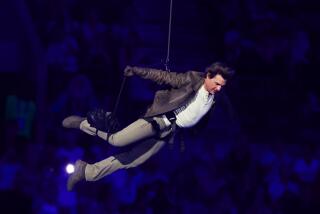It Takes More Than a Village
- Share via
SESTRIERE, Italy — The 2006 Turin Games are not in Turin.
They cannot be found amid grim office buildings and hard-bitten streets of a working city where there is hardly any snow on the ground. Nor among the people who, truth be told, admit to mixed emotions about being the host city to the world’s grandest sporting event.
To find these Games, you must drive an hour or so up winding roads, into the Alps as jagged and glistening as broken glass.
The Games live in the resort of Sestriere, where vendors put cheese, loaves of bread and bottles of grappa outside to tempt passersby.
And in the narrow, cobbled lanes of Sauze d’Oulx, bubbling with noontime crowds, excited chatter in so many tongues that the amalgamation forms a language of its own.
This is where the Olympics reside, in white mountains where athletes are getting down to the business of sports ranging from Alpine skiing to the bobsleigh.
“We were in Turin before,” said Ian Johnston, a fan who traveled from Calgary, Canada. “We didn’t even notice the Olympics were going on there.”
Johnston and his buddy, Joe Mack, soon made their way to Sestriere. A day after watching the men’s downhill, they walked along the town’s promenade with its bright banners and crowds of visitors and competitors from the nearby athletes’ village.
“It’s better up here,” Mack said. “You can tell something’s happening.”
The history of this region dates to pre-Roman times, stories of barbarian raids and Hannibal with his elephants, an ever-shifting border between Italy and France. Hillsides are dotted with ruins of castles, and, somehow, the Olympics seem right at home.
In Sestriere, they cannot be escaped. The slalom course has been marked across a slope that looms directly over the town, awash in floodlights each night, visible from streets and bedroom windows.
Half an hour down the road, the people of Cesana can likewise gaze up the mountainside above their homes and see fireworks bursting over the luge track, where Italy’s Armin Zoeggeler won the host nation’s first gold medal Sunday.
A cluster of wood-and-stone buildings with steep roofs, pinched into the crevice of a valley, Cesana has put rows of flags in the roundabout and an Olympic torch beside an icy river that runs along the highway.
This is a romantic vision of the Winter Games and even the Italians seem to understand.
Turin is “not so beautiful,” said Roberto Carini, a freelance videographer who left his home in the city to spend the Olympics at higher altitude. “I like it here, the ancient houses, the typical style of mountain architecture.”
The Turin Games are not the first to suffer from a sense of topographical disconnect. Albertville, France, was much the same in 1992, as was Nagano, Japan, in 1998.
In an era of sport as spectacle, however, you cannot stage an entire Olympics in the mountains. There isn’t room for the opening ceremony and its massive stadium, the gaudy arenas that house marquee events such as figure skating and hockey.
Some cities -- Calgary and Salt Lake City, for instance -- lent themselves to a festive atmosphere. Those places were clean and new, like an apartment with white walls upon which the Olympic movement could paint its colors.
Turin does not fall into the same category. It was built on the grit of the car industry, home to Fiat, awash in shades of gray.
The spirit of the Games might be evident at the major venues, at certain bars along the river and rented houses where the sports federations from various nations throw nightly parties, but you can drive for blocks at a time with hardly a visual clue that the Games have arrived.
“There’s people everywhere, and it gets kind of diluted,” said Derek Redd, a Vermont native who is an avowed fan of women’s halfpipe.
The venue for snowboarding is in Bardonecchia, removed from Turin’s bustle by a long bus ride. It is the largest of the mountain venues in terms of population, but that still means only a few thousand people.
“Here,” Redd explained, “everybody’s into the Olympics.”
So this is where the 2006 Turin Games live, in a community that has stood for centuries amid hooked pines and high rock faces.
And beside a frozen river, down a stone-paved alley.
And in a Sestriere plaza where Roxana Lixandru sets out baskets of salami di campagna and ties on a white apron, saying in her broken English, “It is beautiful because of so many people, so many different people who come here. I talk with everyone.”
The Games live in places small enough to give themselves over to the moment.
More to Read
Go beyond the scoreboard
Get the latest on L.A.'s teams in the daily Sports Report newsletter.
You may occasionally receive promotional content from the Los Angeles Times.







